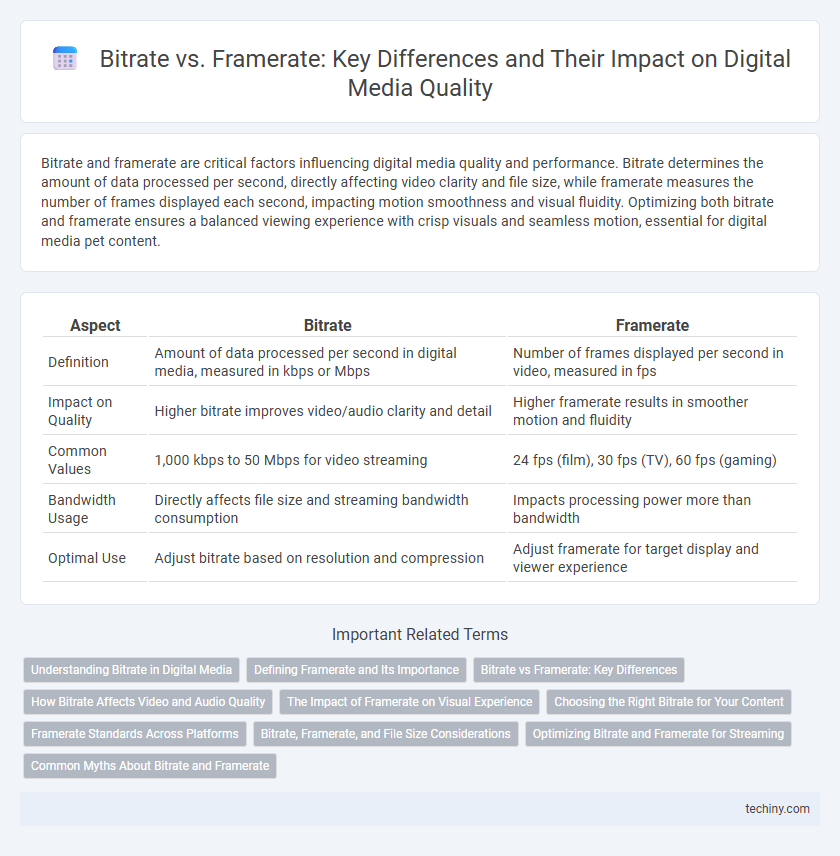Bitrate and framerate are critical factors influencing digital media quality and performance. Bitrate determines the amount of data processed per second, directly affecting video clarity and file size, while framerate measures the number of frames displayed each second, impacting motion smoothness and visual fluidity. Optimizing both bitrate and framerate ensures a balanced viewing experience with crisp visuals and seamless motion, essential for digital media pet content.
Table of Comparison
| Aspect | Bitrate | Framerate |
|---|---|---|
| Definition | Amount of data processed per second in digital media, measured in kbps or Mbps | Number of frames displayed per second in video, measured in fps |
| Impact on Quality | Higher bitrate improves video/audio clarity and detail | Higher framerate results in smoother motion and fluidity |
| Common Values | 1,000 kbps to 50 Mbps for video streaming | 24 fps (film), 30 fps (TV), 60 fps (gaming) |
| Bandwidth Usage | Directly affects file size and streaming bandwidth consumption | Impacts processing power more than bandwidth |
| Optimal Use | Adjust bitrate based on resolution and compression | Adjust framerate for target display and viewer experience |
Understanding Bitrate in Digital Media
Bitrate in digital media refers to the amount of data processed per second during video or audio playback, directly impacting quality and file size. Higher bitrate typically yields sharper images and clearer sound but requires more storage and bandwidth. Understanding bitrate is essential for optimizing digital media performance across diverse platforms and devices.
Defining Framerate and Its Importance
Framerate, measured in frames per second (fps), determines how many individual images are displayed each second in digital media, directly influencing motion smoothness and viewer experience. A higher framerate, such as 60fps, provides fluid motion essential for fast-paced content like gaming or sports, while lower framerates like 24fps are commonly used for cinematic effects. Understanding framerate is crucial for optimizing video quality and performance, as it impacts file size and bandwidth requirements compared to bitrate, which controls data transfer rate.
Bitrate vs Framerate: Key Differences
Bitrate measures the amount of data transmitted per second in digital media, directly impacting video quality and file size, while framerate refers to the number of frames displayed per second, affecting motion smoothness and visual fluidity. Higher bitrate allows for more detailed video encoding, reducing compression artifacts, whereas higher framerate enhances the viewing experience with smoother transitions in motion. Understanding the key differences between bitrate and framerate is essential for optimizing video streaming, editing, and playback performance across various digital platforms.
How Bitrate Affects Video and Audio Quality
Bitrate directly influences both video and audio quality by determining the amount of data processed per second, with higher bitrates allowing for more detailed and clearer media output. A low bitrate can cause pixelation, blockiness, and audio distortion due to insufficient data allocation, particularly noticeable in fast-motion video or complex soundtracks. Optimal bitrate settings balance file size and quality, ensuring smooth playback while preserving fine visual details and crisp audio fidelity.
The Impact of Framerate on Visual Experience
Higher framerates, measured in frames per second (fps), significantly enhance the visual experience by producing smoother motion and reducing blur, especially in fast-paced digital media content such as gaming and sports broadcasts. While bitrate determines video quality by controlling data compression and resolution, framerate directly influences motion clarity and fluidity, making it crucial for immersive viewing experiences. Balancing optimal framerate with sufficient bitrate ensures sharp visuals without sacrificing seamless motion in digital video playback.
Choosing the Right Bitrate for Your Content
Selecting the optimal bitrate depends on the framerate and the type of digital media content you are producing, as higher framerates require increased bitrates to maintain video quality and minimize compression artifacts. Streaming platforms often recommend a bitrate range based on resolution and framerate, such as 5,000 to 8,000 kbps for 1080p at 60fps, to ensure smooth playback and visual clarity. Balancing bitrate with encoding efficiency and audience bandwidth capabilities enhances viewer experience while preventing buffering and quality degradation.
Framerate Standards Across Platforms
Framerate standards vary significantly across digital media platforms, with most online video services supporting 24, 30, and 60 frames per second (fps) to balance smooth motion and bandwidth efficiency. Streaming platforms like YouTube and Twitch often use 30 or 60fps for live content, ensuring fluid playback, while cinema broadcasts typically adhere to 24fps to preserve cinematic quality. Game streaming and high-motion sports content favor higher framerates such as 60fps to deliver clearer and more responsive visuals.
Bitrate, Framerate, and File Size Considerations
Bitrate directly affects video quality and file size, with higher bitrates delivering clearer images while increasing storage requirements. Framerate determines the smoothness of motion, typically measured in frames per second (fps), where higher fps results in more fluid playback but can also increase the bitrate needed. Balancing bitrate and framerate is crucial for optimizing file size without compromising visual quality, especially in streaming and digital media platforms.
Optimizing Bitrate and Framerate for Streaming
Optimizing bitrate and framerate is crucial for high-quality digital media streaming, as bitrate controls the data per second, impacting video clarity, while framerate determines the smoothness of motion. Selecting an appropriate bitrate ensures minimal buffering by adapting to network conditions, and balancing it with framerate prevents excessive bandwidth consumption without sacrificing playback fluidity. Streaming platforms commonly use adaptive bitrate streaming technology to dynamically adjust these parameters, enhancing viewer experience across diverse device capabilities and internet speeds.
Common Myths About Bitrate and Framerate
Common myths about bitrate and framerate often confuse viewers, such as the belief that higher framerate automatically means better video quality regardless of bitrate. In reality, sufficient bitrate is essential to maintain clarity and reduce compression artifacts, even at high framerates like 60fps. Effective video streaming balances bitrate and framerate to optimize visual smoothness and detail without causing buffering or excessive data use.
Bitrate vs Framerate Infographic

 techiny.com
techiny.com